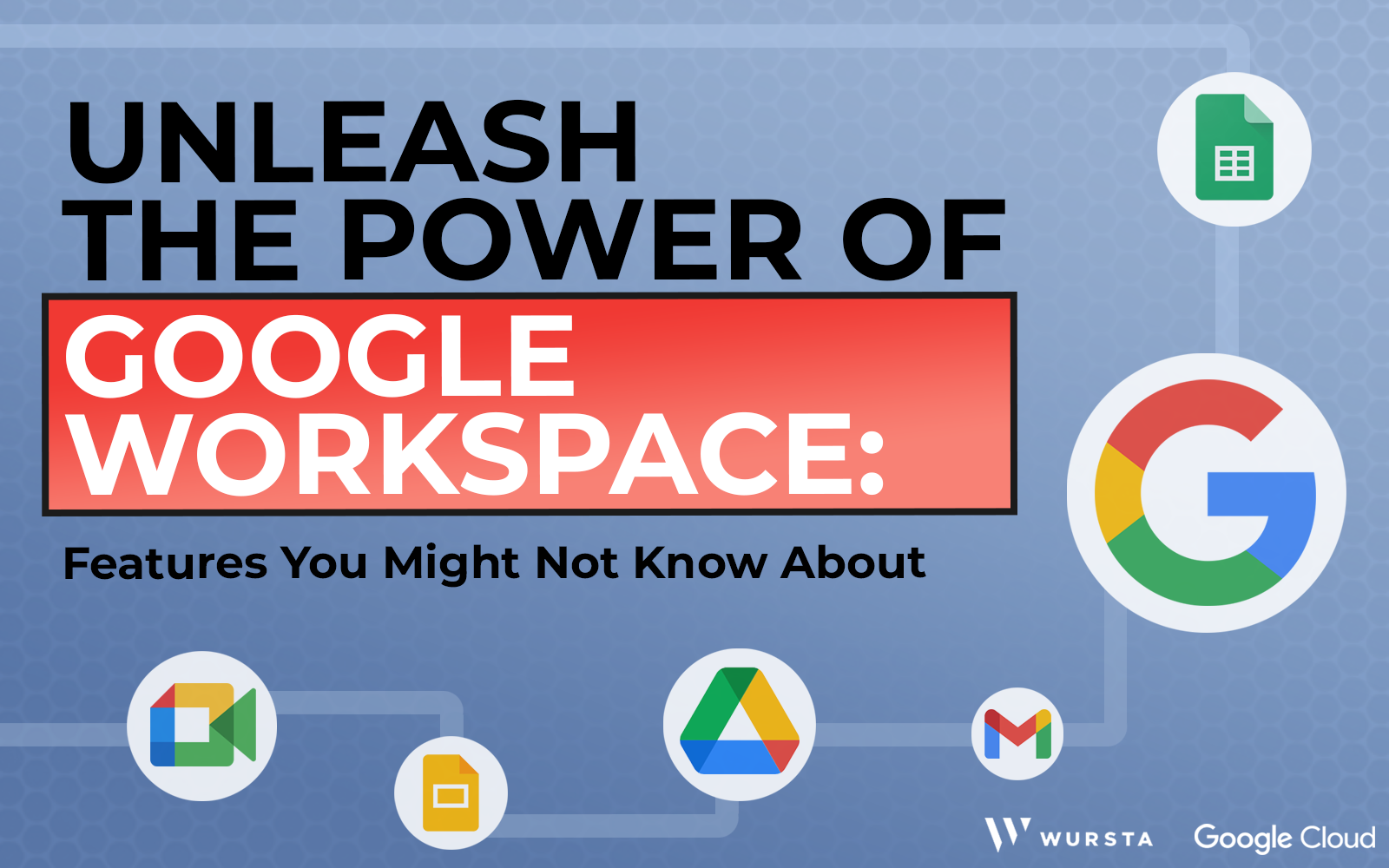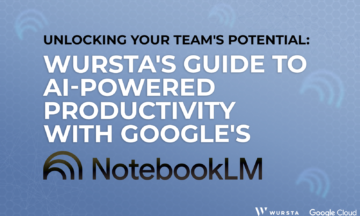Unleash the Power of Google Workspace: Features You Might Not Know About

Google Workspace, a suite of productivity and collaboration tools, is full of features that often surprise even seasoned users. Beyond its core functionalities like Docs, Sheets, and Slides, there’s a treasure trove of advanced features that can supercharge your workflow. Wursta has put together a guide below of some of these hidden gems.
Google Meet: Elevate Your Virtual Meetings
Speaker View
This first feature automatically highlights the active speaker during a meeting, which enhances users’ ability to follow the conversation. By emphasizing the current speaker, it allows participants to stay engaged and ensures a smoother communication flow. This feature is especially helpful in larger group settings, where keeping track of who is speaking can become challenging.
How to use Speaker View: When in a meeting, click the three dots at the bottom right corner of the screen. Then select Change Layout followed by Speaker View.
(…>Change Layout > Speaker View)
Background Noise Reduction
Nobody wants to hear background noise, and with this feature, you won’t have to worry about it. Google Meet utilizes advanced technology to minimize distractions such as keyboard clicks, traffic noise, and even sounds from pets. Not only does this ensure better audio quality for all participants, but it also allows for a more focused and engaging communication experience.
How to use Background Noise Reduction: Click the Settings Gear. Select Audio on the left. There will be an option for Suppress Background Noise that can be adjusted to your needs.
(Settings>Audio>Supress Background Noise)
Live Captions
Don’t you wish real life came with subtitles? With Live Captions, Google Meet provides:
- Real-time transcription of spoken words
- Enhanced accessibility during meetings for individuals with hearing impairments
- Added clarity for those in noisy environments
These ensure that everyone can participate fully and allow for clearer communication and understanding regardless of the setting.
How to use Live Captions: Click Settings and select Accessibility. Next to Live Captions, you can turn it on or off.
(Settings>Accessibilities> Live Captions)
Meeting Recording
Did someone miss a meeting? Or maybe you need a quick refresh. Either way, Meeting Recording lets you capture important discussions and save them to Google Drive for future reference. This feature is ideal for team retrospectives, training sessions, or client presentations, ensuring that valuable insights and information are easily accessible whenever needed.
How to Record a Meeting: On the bottom right of the screen, click Activities, then Recording. Click start recording. There will be a pop-up screen to show that the recording has started. When you are finished, click Activities again, this time selecting Stop Recording.
(Activities>Recording> Start Recording)
Breakout Rooms
Break your meeting down with Breakout Rooms that enable you to divide large meetings into smaller groups for focused discussions. They are perfect for brainstorming sessions, problem-solving activities, or language exchange groups. This format facilitates more engaged participation and allows for deeper conversations among participants by enabling you to divide large meetings into smaller groups for focused discussions. This is perfect for brainstorming sessions, problem-solving activities, or language exchange groups.
How to use Breakout Rooms: When setting up a new meeting, create a new Google Calendar event. Then add Google Meet video conferencing to the event. Add your participants. Select Change Conference Settings. On the left side, select Breakout Rooms. You can then choose the number of breakout rooms and drag participants into different rooms. Finally, remember to save.
(Add new Google Calendar Event> Add Google Meet> Add participants> Select Change Conference Settings> Breakout Rooms>Adjust Rooms as Needed> Save)
Q&A
Connect with your Meet participants directly with Q&A options in Workspace that foster interactive sessions by allowing participants to ask and answer questions directly within the meeting. This approach encourages engagement and promotes knowledge sharing among all attendees, creating a dynamic environment where everyone’s input is valued.
How to use Q&A in Google Meet: Select Host Controls at the bottom left of the screen. Scroll to Meetings activities and turn on Allow Questions in Q&A
(Select Host Controls> Meetings Activities> Turn On Allow Questions)
Polls
Gather instant feedback and insights from your audience with polls in real-time. They simplify the process of gauging understanding, preferences, or decision-making, making it easier for you to assess what resonates best with your audience.
How to use Polls in Google Meet: While in Google Meet, select Activities at the stop. Then, Select the option for Polls. Tap on Start a poll to enter your question and add response options.
(Activities>Polls>Start a Poll)
Google Drive: Your Digital Fortress
Smart Chips
These intelligently suggest relevant people, files, and tasks as you type, saving you time and effort in finding the right information. This feature enhances productivity by streamlining the search process and ensuring you have quick access to the most pertinent resources.
Offline Access
Nothing is more frustrating than being unable to get work done just because you don’t have an internet connection. Offline access empowers you to work seamlessly, even when you’re not connected to the internet. This functionality ensures uninterrupted productivity on the go, allowing you to stay efficient and focused regardless of your online status.
File Version History
Is your previous work better? No worries! This feature allows you to track changes made to your files, allowing you to revert to previous versions. This functionality serves as a safety net, providing peace of mind as you work, knowing that you can always return to an earlier iteration if needed.
How to access previous file versions in Google Drive: Access Google Drive and open your file. Click File, then Version History, and lastly, see Version History. Select a timestamp to see a previous version of the tile. To revert to the earlier version, click Restore this Version.
(File>Version History> See Version History> Restore)
Google Docs: Write Smarter, Faster
Voice Typing
Stop typing and start talking! Dictate your thoughts directly into your document, making it an ideal solution for those who need a hands-free approach or want to take quick notes. This feature enhances productivity by enabling users to express their ideas verbally, simplifying the writing process and saving time.
How to use Voice Typing in Google Docs: Open the Google Docs in a supported browser. Select Tools, then Voice Typing. A microphone box should appear. When you are ready to speak, click the microphone. Remember to speak clearly and at a normal volume and pace. When finished, you can end the session by clicking the microphone again.
(Google Docs> Tools> Voice Typing> Microphone Box)
Smart Compose
You don’t have to do it on your own. Smart Compose suggests text completions as you type, which helps to accelerate the writing process and reduce typing errors. By providing intelligent recommendations, it streamlines the process of crafting messages, emails, or documents, making writing more efficient and less prone to mistakes. This not only saves time but also enhances overall productivity, allowing users to focus more on their ideas rather than getting caught up in the mechanics of typing.
How to use Smart Compose in Google Docs: Just start typing! As you type, suggestions will appear, and you can press either the tab key or the right arrow key, and the suggested text will become a part of your document.
Drawing Tools
Give them something to look at and visualize your ideas through custom diagrams, flowcharts, and illustrations. Utilizing these tools can enhance clarity and understanding, making complex concepts easier to communicate and comprehend.
How to use Drawing Tools in Google Docs: Using the Insert drop-down menu, select Drawing Tools. From there you can edit, upload, and insert any number of images, graphics, and more!
Want to learn more about Google Docs features? Check out our blog on Using Gemini AI in Google Docs here.
Google Sheets: Data Analysis, Reimagined
Pivot Tables
These are powerful tools and an excellent way to analyze and summarize large datasets, allowing users to uncover insights and trends that might not be immediately apparent. By organizing and manipulating data effectively, pivot tables enable a clearer understanding of the information at hand, making it easier to identify patterns and draw meaningful conclusions from complex datasets.
How to Use Pivot Tables in Google Sheets:
- Select the data range you want to analyze, including each column’s header.
- Click the Insert drop-down menu and select Pivot Table.
- Choose the destination for your table in a new or previously existing sheet.
(Select Data>Insert>Pivot Table)
Conditional Formatting
Conditional Formatting is a valuable tool that helps you highlight important data points with
visual cues, making it easier to identify patterns and anomalies in your datasets. This feature enhances your ability to quickly analyze information by drawing attention to significant values or trends, facilitating more effective decision-making.
How to use Conditional Formatting in Google Sheets: Select the range you want to format. Select Format and then Conditional Formatting. From there, you can add your custom format formula.
Data Validation
Data validation plays a crucial role in ensuring data quality by enforcing specific rules and restrictions on input. This process helps prevent errors and inconsistencies, ultimately leading to more accurate and reliable data. By applying these rules, organizations can maintain the integrity of their data, which is essential for effective decision-making and analysis.
How to use Data Validation in Google Sheets:
- Select the data range for which you want to set your rule.
- Select Data Validation.
- Define your rule criteria and your error message.
- Select save.
Google Slides: Captivating Presentations, Simplified
Presenter Mode
Keep your notes all in one place and easily accessible during a presentation. Presenter Mode offers a specialized view tailored for presenters, which displays speaker notes and a timer while minimizing distractions for the audience. This feature enhances the presentation experience by allowing the presenter to focus on delivering their message effectively without the interference of unnecessary on-screen elements.
How to use Present Mode in Google Slides: In the top right corner, next to slide show, click the Down arrow and select Presenter view.
Remote Control
Any mobile device can act as a remote control for your presentation, significantly enhancing flexibility and interactivity. This feature enables presenters to engage with their audience more effectively by moving freely around the space while still controlling the flow of their presentation.
How to use your phone as a remote control for Google Slides: On the top right of the presentation, select Present with Remote. Wait until the presentation is fully loaded and click on the Show ID & Start Remote, and you will be given a 6-digit code. On your phone, open www.remoteforslides.com in your browser and enter the 6-digit code to connect your phone to your presentation.
Custom Themes
Get creative! Custom themes allow you to create stunning presentations with personalized branding, ensuring they align seamlessly with your organization’s style and messaging. These themes provide a unique opportunity to represent your brand effectively, making your presentations visually appealing and consistent with your overall identity.
How to use Customer Themes for Google Slides: At the bottom right of the screen, click Import Theme. Then, double-click the presentation you want to use and select the theme you want. Click Import theme.
Google Workspace is packed with features that can significantly enhance your productivity and collaboration efforts. From the dynamic capabilities of Google Meet to the efficient tools in Google Drive and Docs, these hidden gems are designed to streamline your work processes and foster better team communication. Experiment with these hidden gems to boost your productivity and elevate your collaboration experience. By exploring and utilizing these advanced functionalities, you can unlock your full potential, save time, and create a more engaging work environment. So, whether leading a meeting, collaborating on a document, or organizing files, take advantage of these tools and elevate your Google Workspace experience to new heights.
To keep up today on more up-to-date tech news and tips, make sure to follow along with our blog. Looking for ways to best integrate Google Workspace into your business? Contact us today to discuss Workspace’s full potential to take your business to the next level.



